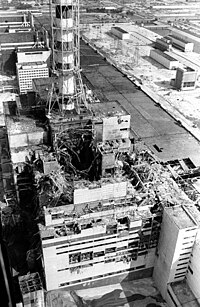
Photo from wikipedia
Abstract Here, in situ ion irradiation and rate theory calculations were employed to directly compare the radiation resistance of an oxide dispersion strengthened alloy with that of a conventional ferritic/martensitic… Click to show full abstract
Abstract Here, in situ ion irradiation and rate theory calculations were employed to directly compare the radiation resistance of an oxide dispersion strengthened alloy with that of a conventional ferritic/martensitic alloy. Compared to the rapid buildup of dislocation loops, loop growth, and formation of network dislocations in the conventional ferritic/martensitic alloy, the superior radiation resistance of the oxide dispersion strengthened alloy is manifested by its stable dislocation structure under the same irradiation conditions. The results are consistent with rate theory calculations, which show that high-density nanoparticles can significantly reduce freely migrating defects and suppress the buildup of clustered defects.
Journal Title: Scripta Materialia
Year Published: 2018
Link to full text (if available)
Share on Social Media: Sign Up to like & get
recommendations!